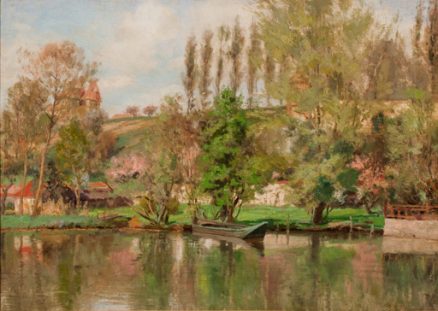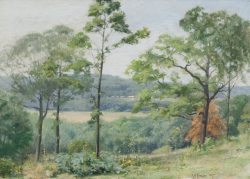Untitled (Landscape with River and Boat)
, circa 1908Oil on canvas, 20 by 28 inches
- Categories
- Landscapes
- Zoom in on Artwork
- Print Page
- Email Page to Friend
Charles Francis Browne’s rural landscape image focuses on an expanse of reflective water bounded by a low bank, beyond which a ridge rises sharply toward a fair-weather sky. Trees scattered along the shore and a line of slender poplars crowning the summit partly screen buildings that contribute touches of pink, white, and red to a composition dominated by rich greens suggestive of springtime. Along the riverbank, the structures are humble one-story houses; higher up is a more massive house with a tall mansard roof on the left and a high wall and corner tower on the right. A moored boat near the center emphasizes the deserted character of the scene.
The red roofs and whitewashed walls of the houses, as well as the flat-bottomed boat with its distinctive tipped-up prow, identify the setting of Browne’s painting as rural northern France. Browne first painted landscapes there in the late 1880s, when he was a student in Paris. Although he championed the midwestern scene as an artistic subject for local painters, he made several return trips to France to portray settings long known as artists’ haunts. In 1903–1904 he worked near the famed Forest of Fontainebleau. In the village of Montigny, the relatively narrow span of the Loing River afforded a close view of tree-sheltered banks and a steeply rising hill on the opposite shore. Untitled (Landscape with River and Boat) may well be among the landscapes Browne painted at Montigny, a group of which were exhibited in his solo show at the Art Institute of Chicago in late 1904.
This work typifies Browne’s combination of crisply observed detail and loosely applied but blended paint, which results in a soft effect similar to that of pastel. Browne’s technique suited his intimate, small-scale portrayals of settings notable for their quietly unpretentious yet picturesque character. Having modified his earlier reservations about the strong color and broken brushwork of impressionism, Browne began to work in the mode’s brighter tints and adopted its characteristic method of on-site execution in the decade of the 1900s. This landscape is a transitional work that demonstrates the artist’s continuing allegiance to naturalism and local color, which he would temper with elements of impressionist practice in the following decade in such paintings as From Eagle’s Nest.
Wendy Greenhouse, PhD
Donated by M. Christine Schwartz to The Richard H. Driehaus Museum, Chicago, Illinois, in 2021

